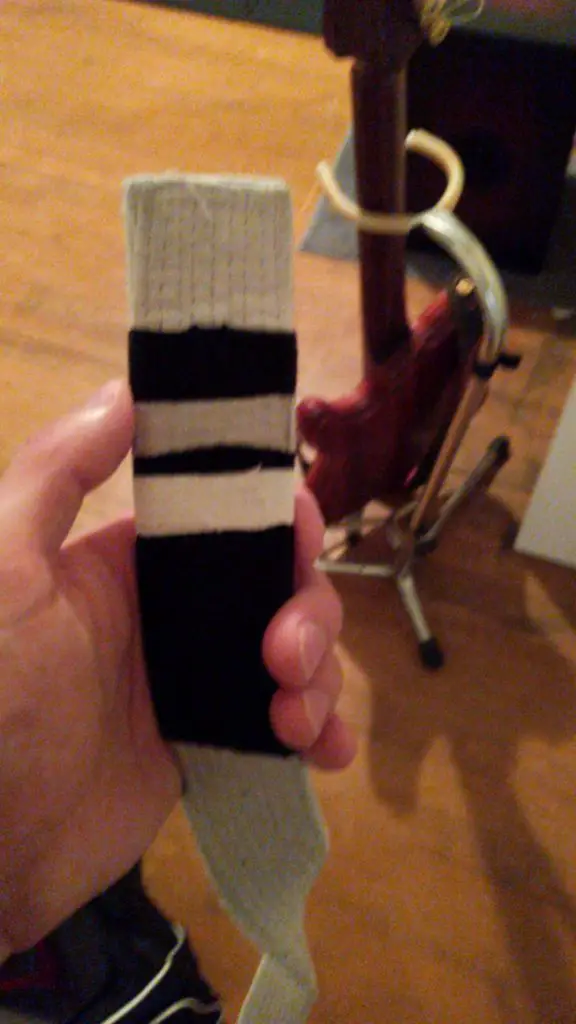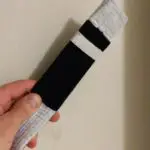Did you just receive your first stripe in Jiu-Jitsu and now you’re excited to get the second stripe? Maybe you’ve had your second stripe for a few months and are wondering what it takes to get your second stripe. It can be addicting to try to rank up, especially when others around you are doing the same. In this post, I’ll cover what do two stripes mean? How long does it take? What are the requirements for two stripes?
Two stripes on a white belt generally mean a student has been training for 6-12 months, understands the basic concepts and techniques, and is starting to attempt sweeps and submissions. The students will also know about the basic Jiu-Jitsu positions, have a few escapes they can use, and know some guard passes.

What Do Two Stripes Mean On a White-Belt?
Two stripes on a white belt can mean serval things depending on how the instructor grades their students. It can signify the time the student has been training. The student’s overall ability. Or, it can be a combination of both time training and the technical ability of the student.
Some instructors do not use stripes at any belt rank, including a white belt. So, if you still haven’t received your first stripe and you know someone that is training at another facility with stripes, ask your instructor what their methods are!
If someone does have two stripes on their white belt you can expect that they have trained for at least 6-12 months or have previous grappling experience.
How Long Does It Take To Get The Second Stripe?
Receiving your second stripe in Jiu-Jitsu generally takes 6-12 months of consistent training. Of course, it is dependant on the instructor’s requirements and students’ abilities. Three factors can play into when you get the second stripe: time training, technical ability, and the instructor’s requirements.
Time On The Mats
Time is often a to determine when stripes are awarded to white belts. A white belt that trains at a gym that uses time could expect to receive their second stripe in the same amount of time it took to get their first stripe. For example, if your gym gave you your first stripe after 4 months of consistent training, expect your second stripe ~4 months after receiving your first stripe.
Another method that could be used is that your first stripe may take 4 months to acquire, while the second stripe takes 6 months to receive, the third 8 months, and so on.
If time is used at your academy try to practice the techniques taught as often as you can to get proficient at them. While receiving a stripe feels good, it is not a substitute for technique.
Technical Ability
The technical ability of a student could determine when the second stripe is achieved. If you have an athletic background or are used to moving your body you might receive your second stripe quicker than someone that doesn’t. There are cases that someone with a wrestling background got their second stripe after a month of training! Whereas, someone with no athletics background may take up to 8 months to a year.
The ability to learn and retain techniques will also play a role in how fast you get your second stripe. Having the ability to recognize and implements new techniques will set you on pace to get your second stripe in 6-8 months from when you first started training.
Instructor’s Discretion
Instructors may use time and student’s ability to determine when it is time to give out a second stripe. An instructor may want to see the student be on the mats for at least 8 months from when they began and be able to show some technical proficiency in the fundamentals.
It may be hard to know if the instructor is using a combination of both skill and time, even after you have received your first stripe. If getting stripes is important for you and motivation it may be good to ask your instructor to know what their requirements are!
What Are The Requirements?
The main criteria for receiving your second stripe on your white belt will be showing that the fundamental techniques are becoming more refined. When faced against an opponent in Jiu-Jitsu you’re able to demonstrate some understanding of the fundamental techniques, sweeps, and submissions. You may not be able to finish the sweep or submission, but the understanding is there and the refine will come later.
Improving the following fundamentals techniques will be important to unlocking the second stripe in Jiu-Jitsu:
- Shrimping
- Forward/Backwards Roll
- Technical Stand up
- Maintaining and escaping the guard
- Basic Side Control Pressure
- Basic frames from the bottom while in side control
- Mount prevention
- Basic mount retention
- Hip escape from mount
- Back mount
- Turtle
Learning more about sweeps, submission setups and submissions will start making their way into your training. Techniques that most beginners will learn are:
- Stack pass
- Tornado pass
- Knee cut
- Scissor sweep
- Hip bump sweep
- Armbar
- Triangle
- Kimura
The second stripe doesn’t mean these techniques will be perfected – by any means. You’ll know about them and know some of the details associated with them. You may find success with a few of the techniques too! The main thing is you’re improving, learning, and retaining more information than when you first got your first stripe.
Demonstration Of Technical Ability
There are a few factors that can affect getting the second stripe when the technical ability of a student is used. The athletic background of the student and/or how quickly the student can learn and retain techniques.
The athletic background of someone can play a role in how fast they rank up. If you were a wrestler in high school or college you’re going to have the fundamental requirements needed to control your opponents. An understanding of takedowns, positions, and moving your body are going to be skills you already have. Learning a new technique and utilizing it will come much quicker than someone who does not have a grappling background.
In general, if you do have an athletic background in any sport or exercise you will be used to moving your body. You will already have the discipline to practice the techniques.
The ability to learn and retain information will also play a role in how fast you’ll get your second stripe. Retaining and improving the fundamental techniques like shrimping, bridging, positons, will help you succeed when learning more techniques. Whenever a side control escape is taught, as long as you remember how to bridge and shrimp correctly, you’ll have an advantage.
Recognizing leverages and positions within other techniques will help learn new skills. This may not sound possible now, but it will be something you start picking up on your way to the second stripe!
Instructors Requirements
Different instructors will have different requirements for their students to rank up in Jiu-Jitsu. Some instructors use mat time, technical ability, or a combination of both. If you’re concerned that you’re not getting your second stripe, ask your instructor what their criteria are for the next stripe.
Some instructors have hundreds of students that come into the gym, it’s hard to remember everyone! Other instructors are forgetful and may not realize you’ve been at the gym as long as you are. Most of the time, the instructors want all their students to be held to high standards – which will differ from person to person!
Someone that is 60 years old will have different requirements than someone that is 20. Knowledge of techniques and the ability to perform them in drills or situational rolling may be a requirement for someone older. While someone that is 20 s expected to know them and perform them more regularly in rolling.
Don’t get caught up on when you get the second stripe, learn and practice as much as you can and it’ll come. And, if it is the driving force behind your training ask your instructor!
Conclusion
To get the second stripe on your white belt will require you to know and have a better understanding of the basic techniques in Jiu-Jitsu. You can expect to get your second stripe 3-6 months after you have received your first stripe; however, the requirements will differ from instructor to instructor.
If you are unsure why you haven’t received your second stripe, ask your instructor what their requirements are or what techniques you should be working on. It’s important to not get discouraged or put weight into the white-belt stripes. They are typically used more to know who is a fresh white belt for rolling sessions or to give motivation to new students who may otherwise quit.
Focus on training and the stripes and belt promotions will come naturally. It’s more important to improve techniques and retain information than to strive for the next stripe!


